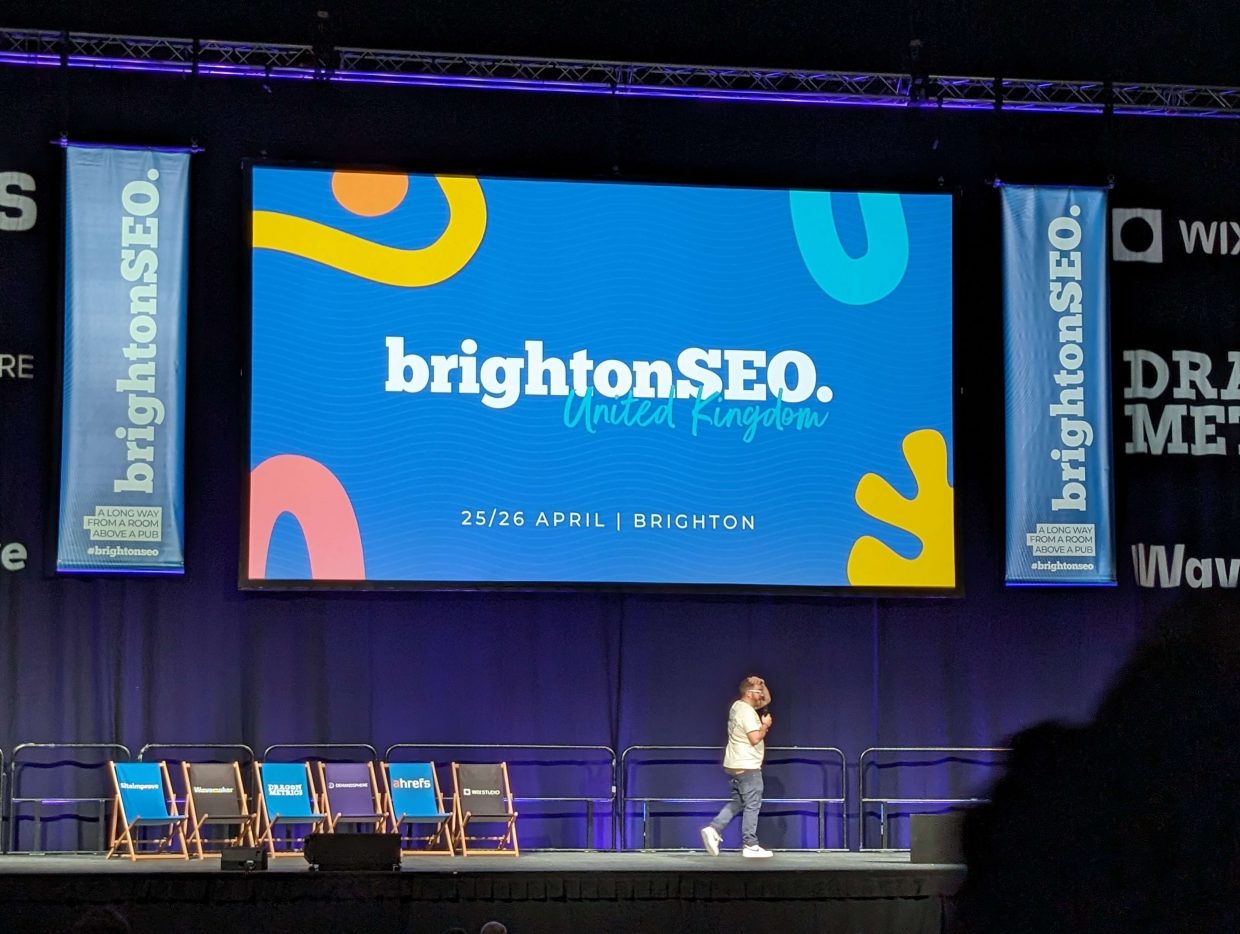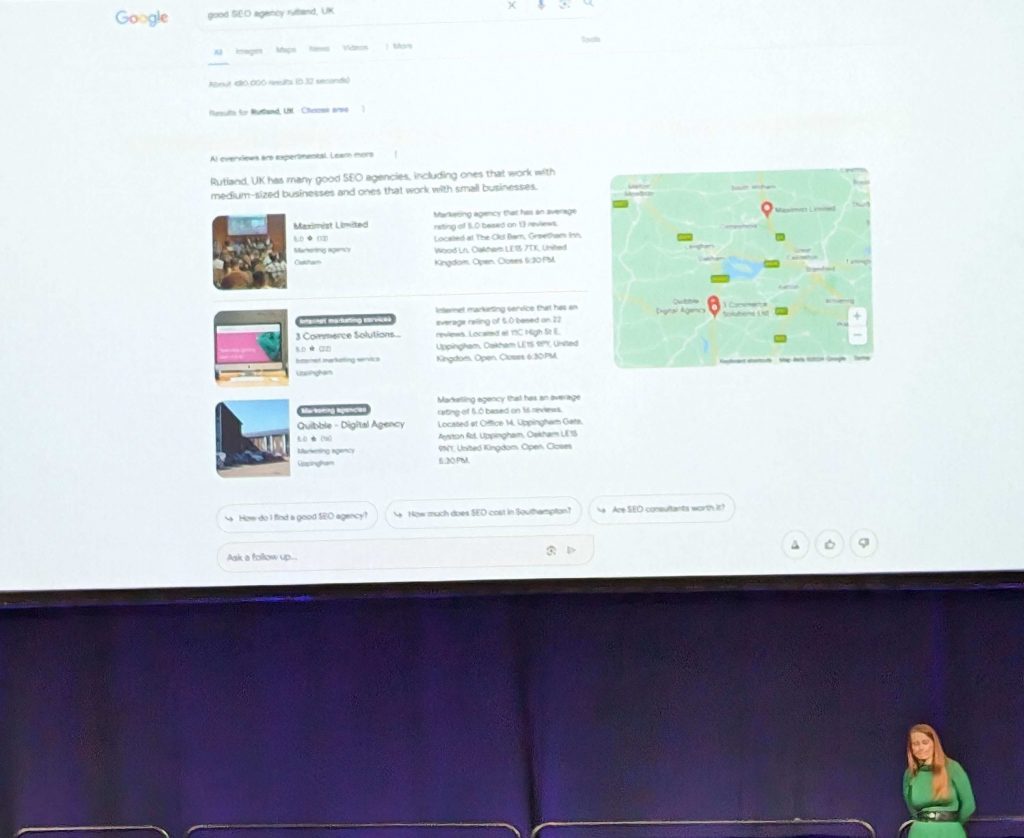BrightonSEO Lessons: Content Strategy in 2024
Our team travelled to Brighton for the biggest SEO conference in the world: BrightonSEO. It’s come a long way from a room above a pub, they say…
Because of the sheer quantity of talks, tips and strategies shared at this event, we can’t include everything. This is the first blog in a new series which will cover the most interesting insights, organised by topic. First, we’ll look at content strategy.
What kind of content will you focus on? How much of it will you produce? Across which platforms? How will you measure success?
A good content strategy is:
- Informed by current content performance
- Targeted using audience profiles
- Time-bound and Measurable
New Thinking on Content Strategy
With the launch of Google SGE coming this month, and search intent forming a much bigger part of the picture than in previous years, there is a lot to discuss this year. The main question on our minds was:
“How do we plan content that creates resilient organic traffic for our clients during all this change?”
Three speakers in the Content Strategy session had different takes on what SEO content writers should prioritise.
1. Preparing for Google SGE
Anna Morrish of Quibble shared content strategies for AI-integrated search. Google SGE will show AI-generated answers before organic website results. As a result, SEO’s are currently analysing how to mitigate losses in organic traffic, which Morrish says may drop by 20-60% in May 2024.
From analysing results during the SGE trial period, Morrish suggests the main areas to focus on will be category content and Google reviews. These are the main decision-making areas that are summarised by SGE, with links to information sources included in the answers.
Using ‘labyrinth movie gifts’ as a sample search query, Morrish demonstrated that SGE will suggest various expansions of the query by category. If category content on eCommerce sites lists helpful information that other providers don’t, the SGE may list your categories over others and cite your website as a source.
She also showed that local business reviews appear as a summary in Google SGE. Like category content, if your Google Reviews include specific language about services, the SGE experience will be more effective.
We’re looking at the questions audiences are asking about our clients’ products and services to understand content gaps and create content to fill them.
Research from STAT (Moz) points to a net benefit for SEOs. The data suggests that users in the US rarely see SGE results by default. Instead, they are triggered by “Generate” buttons, giving users control.
This means the top 5 results will not be completely obscured by the “Generate” button, so your high-ranking pages will still have value.
They also found that sites referenced in 55% of SGE results “did not actually appear in the top 10 organic results for the same SERP.” As we know from the introduction of Featured Snippets and People Also Asked, search users look around for context, even when Google is feeding them key information directly. Lower-ranking pages with specific and useful information may still gain clicks as citations in the SGE’s references.
3 key tips to prepare websites for Google SGE:
Here’s how we can make sure websites are ready for this AI integration and minimise drops in organic traffic.
- Keep content short and to the point.
- Make it personal where possible
- Encourage specific reviews for local businesses
The introduction of AI content isn’t necessarily going to cause a huge shift in metrics. SGE will only appear for users who log into a Google account in their browser, and won’t necessarily show up automatically. This feature is not yet available to more than a ‘small slice’ of UK users, so stay tuned for more detail as the roll-out progresses this month.
2. Target Users who are Ready to Buy with Comparison Posts
Araminta Robertson of Mint Studios shared data on real content that mentions competitors without directing traffic away. Conventional wisdom has been that writing about competitors will simply make users aware of other options and potentially lose sales. Robertson skewers this logic as old-fashioned.
“Customers already know about your competitors” she says, and backs it up:
- They’re doing 3x the research they were doing in the 2010s
- They’re seeing targeted ads the second they start searching for products like yours
- With smartphones, searching multiple sites and products at once is quicker and easier.
Robertson’s rationale for prioritising comparisons was convincing: Comparison posts double conversion rates, and double the size of the deals they lead to. 
This is because comparing your solution to your competitors’ targets people who are ready to buy. At this funnel stage, people crave comparisons, as shown by the success of sites like Compare the Market.
Why does this work?
Giving potential buyers a direct comparison between your product and a competitor’s alternative saves them time and cognitive energy.
“You don’t want to write an article that says “Our product is the best” full stop.”
The key is to show the situation in which your solution is best. Robertson suggests structuring the article into three parts.
- First, make a solid case for your product. Use technical details, the problems it solves, and testimonials to show why this product works for the situation.
- Give the straightforward facts of a competitor’s product. You can avoid being overly negative or critical, and you can show the situations in which these products might surpass your own.
- Do the same for a third competitor. Give just the facts.
To Make Comparison Posts Work: Name the Elephant
Robertson also advised writers to build trust with the reader by “naming the elephant in the room”: bias.
By being up-front and acknowledging that we think our product is the best, we can disarm the reader’s cynicism. This helps them assess the products with more openness and presents your brand as honest and down to earth.
3. Sustainable Content is Better SEO
Fiona Brennan of Indie Essentials broke the silence on the environmental impact of server farms. To sustain the internet as it is, with 15 million pieces of content (or 328.77 million terabytes of data) generated daily, millions of servers are running day and night. This uses energy and creates an enormous carbon footprint.
Brennan argued that creating huge volumes of content on every conceivable channel is also unsustainable in human terms, sharing that 50% of content writers are burnt out.
The solution to both of these issues is to create less. Instead:
- Optimise existing content. Use what you have before creating more.
- Improve CRO to make the pages that perform well bring people to the products.
- Reduce your channels to include only the channels that make sense for your target market.
- Don’t be afraid to pivot future messaging towards the audience you’re gaining, rather than trying to target everyone.
We already know that with content, less is more. It’s with gratitude that we share Brennan’s approach as a people-first strategy for content creators as well as internet users.
Content Strategy is Changing: for the better.
We’re relieved, frankly, that SEO content doesn’t need to be long-form, rehashing existing information or produced ad infinitum anymore. It’s exhausting, for content writers and SEOs alike. The new content strategy ushered in by the Helpful Content Update, SGE and anti-spam policies favours lean, specific and informative writing.
When we rewrite content for a client’s website, we start with a content audit. By creating an inventory and analysing each page, we can prioritise high-value pages that need work. Out-of-date, irrelevant pages, such as old blog posts, can be pruned or updated, and any new content is as lean as possible.
A few years ago, the conventional wisdom was to add as much content as possible. This means most websites that have had SEO in the past may need to reduce and distil the information they display to continue seeing good results.
If your website’s rankings have been declining, get in touch for an SEO audit with eSterling.
The Importance of Product Page Content for eCommerce Websites
Product pages often serve as one of the most important landing pages on your website. If a user is searching for a specific product, organic and paid search results are more than likely to be filled with product pages.
This means that your product page needs to provide the perfect amount of information for users and for search engines.
Here’s a checklist to ensure your product pages are performing well in search and reaching the most customers possible.
Product Descriptions
All good product descriptions should clearly and concisely explain what the product does, use language familiar to your target customers and communicate why someone should choose this product over a competitors.
Product descriptions should be written for customers first of all – with a clear tone of voice, persuasive wording and appropriate length. Descriptions that do this and demonstrate the clear value of your products will be a vital tool for leading your customers through the sales funnel.
However, just as important as selling to potential customers is product copy that targets the most relevant keywords users are going to be searching in Google. Search engine crawlers determine what a product page is trying to sell by scanning and reading the content. If you haven’t included what could potentially be searched by consumers in your copy, you could be missing out on a lot of search traffic. Keywords should be included naturally into the content, and not stuffed in just for the sake of SEO.
Product descriptions should also be unique for every product. Duplicated content can be a significant issue for SEO and should be avoided when possible, especially for large eCommerce websites.
Product Specifications & Information
Online customers are lazy. When viewing a product page, they want all the information they need in front of them and are often put off by having to click through to other pages to find what they need.
This is why all relevant product information should be clearly displayed on product pages. This can include prices, shipping costs, product size, product colours, and technical information.
Including as much relevant information as possible is always useful to the customer as they can understand the product completely by viewing one page. This will encourage them to move them down the conversion funnel in the simplest way possible.
Product Images/Videos
Product imagery is often the first thing a customer will see on a product page. For this reason, you should ensure that your products images look as desirable and as high quality as possible.
9 out of 10 users have said that product images directly affect their purchasing decisions, so it’s vital to get it right.
Every image should be as high quality as possible while still staying under image size guidelines. Images that are stretched or too compressed will instantly send red flags to potential customers.
A range of images that shows your product from different angles is also preferable, especially if your products are dependent on their aesthetics. Having multiple images for each product variation is also a great way to show your customers exactly what they are buying.
Aside from just looking great, your images need to be helpful and answer questions your customer may have about a product. An image needs to give an idea of how it can be used and why they need to buy it.
Videos have also become a useful tool for eCommerce sites. Including videos on your product pages allows sites to give a much deeper insight into a product than a simple image. A video can include voice over and in-depth product demonstrations. This can be a powerful way of showing why a customer should purchase a product.
Product Reviews
Social proof is a powerful tool within eCommerce. Seeing what someone else thought of a product can be one of the main things that helps a user decide on making a purchase.
The immediate benefit of reviews is that they can make your future customers feel that much more confident. Having this clearly displayed on a product page increases the chance that they a user will make the decision there and then.
If you need help on creating the best product pages possible, get in touch with eSterling! We are experts in eCommerce web design and digital marketing and have the knowledge and tools to help you create product pages that get users to click that buy button!
Headline writing tips to get more business

Browsers are fickle. If you want to convert a visitor into a customer you need to instantly grab their attention. Beyond eye catching images, bullet points and benefits (not features!) you need to focus on your headlines.
In the world of content strategists and copywriters they call this microcontent and we’re going to show you how to improve yours.
You only get a sentence, that’s 40 to 60 letters, to work with. That’s a lot less that a tweet so every word counts. This kind of text is also displayed usually without context. Sure, it may be displayed with an image but often those are a little generic or abstract. Because of this you have to write a headline that stands on its own.
Here are a few hints on writing that perfect line of text.
Be clear in what your message is.
Your headline has to be appealing. What are you offering? Why does this benefit the customer?
It has to be relevant to both the site and to the reader. Match the headline to the content.
Be credible. Don’t over exaggerate or make claims that simply are not true.
Be sure to “front-load” your headline. That is, putting the most valuable phrase at the beginning.
Use numbers. “10 reasons good headlines improve online sales!”
Use powerful words like “free” and “imagine”.
Try phrasing your headline as a question. “Want to get more business by writing the perfect headline?”
Be succinct. Remove unnecessary words.
Focus on what the customer will find desirable.
“We promise you this: you are now ready to write great headlines”
Update Your Content Now!
Sorry to sound bossy, but if the content hasn’t been updated on your website for a while, make sure you do it now!
The reason for my urgency is the latest update from Google. This mini amendment to the search engine’s algorithm is rooting out out-of date or spammy content. This means that if you haven’t updated the content on your website for a long time, you may see your keyword rankings drop, or even disappear altogether.
Before you panic at this news, it’s important to remember that Google (usually) makes updates that benefit the user – i.e your customers. No customer wants to read outdated content on your site, so why should Google rate your site if your copy is old?
The most successful websites add fresh content regularly, so you should therefore get into the habit of updating your content often. The easiest way to do this is to start a blog and write posts regularly. This doesn’t have to be a huge job – just a couple of paragraphs weekly would be a good place to start. You can talk about anything you like – industry opinions, company news, new orders, business trips etc – just make sure it’s relevant and well written.
As part of your content overhaul you should also re-write the text on your homepage and about page (plus any other pages that have text present). I have lost count of the number of websites I have seen that display the names of long-gone members of staff, old addresses; or information about an event that happened years ago! Make sure you amend these details as soon as they happen to keep your website fresh and relevant for your customers – and Google will be happy too.
How Do You Spell Success for Your Website? Correctly!
I can’t stress the importance of using correct spelling and grammar on your website enough. Poor spelling creates a bad first impression that can leave a lasting effect when customers choose to shop with your competitors rather than you.
It may surprise you that poor spelling can also harm your SEO efforts. If you repeatedly spell one of your keywords incorrectly, it could have a negative impact on your search engine results because Google won’t be able to find that keyword in the text. If your text is littered with errors it could also lead Google to the conclusion that your site doesn’t have anything useful to say!
It really does pay to get little details right on your website as it creates a good first impression and pleases the search engines. Take some time today to read through your website text and make any corrections that are needed.
Follow these top tips for getting your content right every time:
- Write your content in Word and copy and paste this into your CMS – this will help you to spot spelling and grammar mistakes.
- Read what you have written out loud – it’s the best way to check how your content ‘reads’.
- If in doubt, print your content out. This way you can edit it with your red pen, or give it to a friend or colleague to read.
- Beware of American spelling. Americanisms can lead your customers to the conclusion that you are based in theUSA, which could put them off buying from your site. American spellings can also be confusing toUKsearch engines.
How to write content for your website
When you’re asked by your web agency to write some content for your new web site all you really have as a guide are the page titles (About Us, Company Overview etc.). It’s hard to know what to write about, let alone find the spare hours to write it. That’s why we as Web Designers appreciate it must be difficult to start writing when the day-to-day running of your company takes up so much time.
To get you started here are a few small tips on how to write the perfect content for your web site quickly and painlessly.
What to Write About
What is your industry? Where are you based? What areas do you cover? What are your products? Do you offer services? Why are you different from other companies in your industry?
These are all questions that will need to be answered pretty quickly when a potential customer lands on your web site so answer these questions immediately. Try not to write long sentences and paragraphs if possible – this will immediately turn a potential customer away. Make your copy punchy and interesting, don’t just list the facts – make it personable.
How to write your content
Always bear in mind your ideal keywords when writing for your web site. You may have heard about ‘Keyword Rich Content’ – this is basically a way of writing that includes the words or phrases your potential customer would type into a search engine to find your business – USE IT! A bullet point list is always easy to follow and is a great way of listing services and products.
…and remember, you’re selling your company to the world!
What to do once your content is written
Run spells checks and re-read it all. Here at eSterling we always double check the content our customers send us and we can improve where necessary. Send it to your Web Designers on a word or similar document.
This is just a small article on writing content for the web so if you need any more help please call our help desk on 0121 766 8087 and they will be able to go through all this in greater detail.
Conversion Rate Optimisation
Here are some simple ways to increase you ROI via conversion rate optimisation.
1. Be Relevant
Your ad text or meta description should always be relevant so the user will know what to expect when they arrive on your website. There is no point making wild claims that are not reflected on the site as this will just lead to poor bounce rates. Make sure that you use the keyword in your H1 title as this will help with both users and search engines. Perhaps one of the most vital points to consider in term of relevancy for the user is to use an accurate image. All to often I see generic images used on eCommerce sites, this will do nothing to improve sales. Always use your keywords in crawlable areas of the page as well utilising keywords in the domain if you can.
2. Proposition
You must quickly and simply portray your business proposition to your customer, frame the product or service in your opening text, ensure you prioritise your key features and benefits, consider the best way to get your point across – text, image, Video? Next try to see it from your customers point of view, see if you can handle any objections or concerns they may have about purchasing from you. One final point to consider is not to overwhelm the the user, do not be tempted to bombard them with too much information – an alternative may be to include downloadable demo, white papers or fact sheets. Always use a call to action.
3. Trust
The more trust your site can instill in the user the more sales it will make. This statement is so true for on-line shops. This can be done by the site itself as well as in the promotion of your company brand and the product/service brand. Your main enemies here are scepticism brought about by lack of information, not including reputable 3rd party ratings/awards and badges, and not have an SSL or payment system from a good provider. Try to use trust inspiring text, for example point it out if you have secure check out system, include testimonials in either text or video format. In terms of the web design you need to have a clean and tidy looking site, it should look professional and not rushed or cheap.
4. Understand User Intent
Try to find out what your typical customer responds to, try varied approaches and stick with the one that works best. You could try a softer call to actions or a harder approach, you may wish to experiment with different web designs and ways of presenting data, perhaps you will convert better if you can engage with the customer in a phone call? The key with all the things you try to is to ensure that you have a tested it in a fair way and to measure your success. Once you have a good amount of data you can choose the best way to proceed in terms of your customers intent.
5. Remove Distractions
Remember that the more obstacles you put between the moment a user enters your site and the point of sale the more likley it is that the sale will not complete. Your sales process should be simple, linear and as easy as possible. Common issues are including global navigation on your PPC landing pages, not using technology’s like JQuery to stop users from leaving the sales funnel by utilising tabbed pages of JS overlays to keep users on the page, off topic text and distracting images, asking for too much information from the user just to make the sale.
To find out more about conversion rate optimisation, get in touch with us here at eSterling.
It Pays to Proof Read
Like Tom said last week in his blog post, it only takes three seconds for a customer to make up their mind about your website. If you want your company to come across in the correct light, you must make sure the text on your website is error-free. Spelling, punctuation and grammar must be correct – no excuses!
I know my blog post is starting to sound like a rant from your English teacher, but trust me – good English on your website is an absolute must. Errors in your copy reflect badly on your company because glaring mistakes look unprofessional – especially if a typo gets in the way of the message you are trying to put across. Put yourself in your customers’ shoes – if you can’t get your copy right, will they want to trust you with their money?
Here are my top tips for making sure your website is error-free:
• Write any text for your website in Word. This means you can easily spell-check your writing for errors.
• Get someone else to proof read your text. It’s easy to miss your own mistakes, as your eyes will read what they want to read! Ask a colleague to check your writing, or if you’re alone in the office, read it aloud – you will often spot mistakes this way.
• If in doubt, print it out. It’s hard to read a page of text carefully off a computer screen. Printing your copy to check it will help you to find errors, and you can also write on any corrections to remind yourself to make changes later on.
Taking a little extra time to proof read your website costs nothing – so make sure you do it today! And if you need a little extra help, give eSterling a call for Copywriting services.
Why is Duplicate Content Bad for my Website?
Nobody likes a copycat – especially Google. That’s why having content duplicated on multiple websites is a big no-no when it comes to SEO.
Google will reward your website for having unique content – and will punish accordingly if it doesn’t. Using the same copy from the web throughout your site, for directory listings; or even copying and pasting from another site (naughty you!) can seriously harm your search engine rankings.
We have recently been working with a website which had great rankings throughout Bing, Yahoo and other major search engines, but was not getting anywhere in Google. A search using Copyscape showed that the content on the home page was also being used in a number of directories such as Applegate.
Google was therefore penalising the website thinking that the text had simply been copied from the directories. By re-writing the content for the directories we recovered the search engine positions for this site in Google – happy days!
Make sure that you check your site for duplicate content – and each time you join a directory don’t just copy and paste! Take a little time to re-write your content and Google will love you for it. And if your copy is sloppy, simply get in touch with us about our copywriting service.




